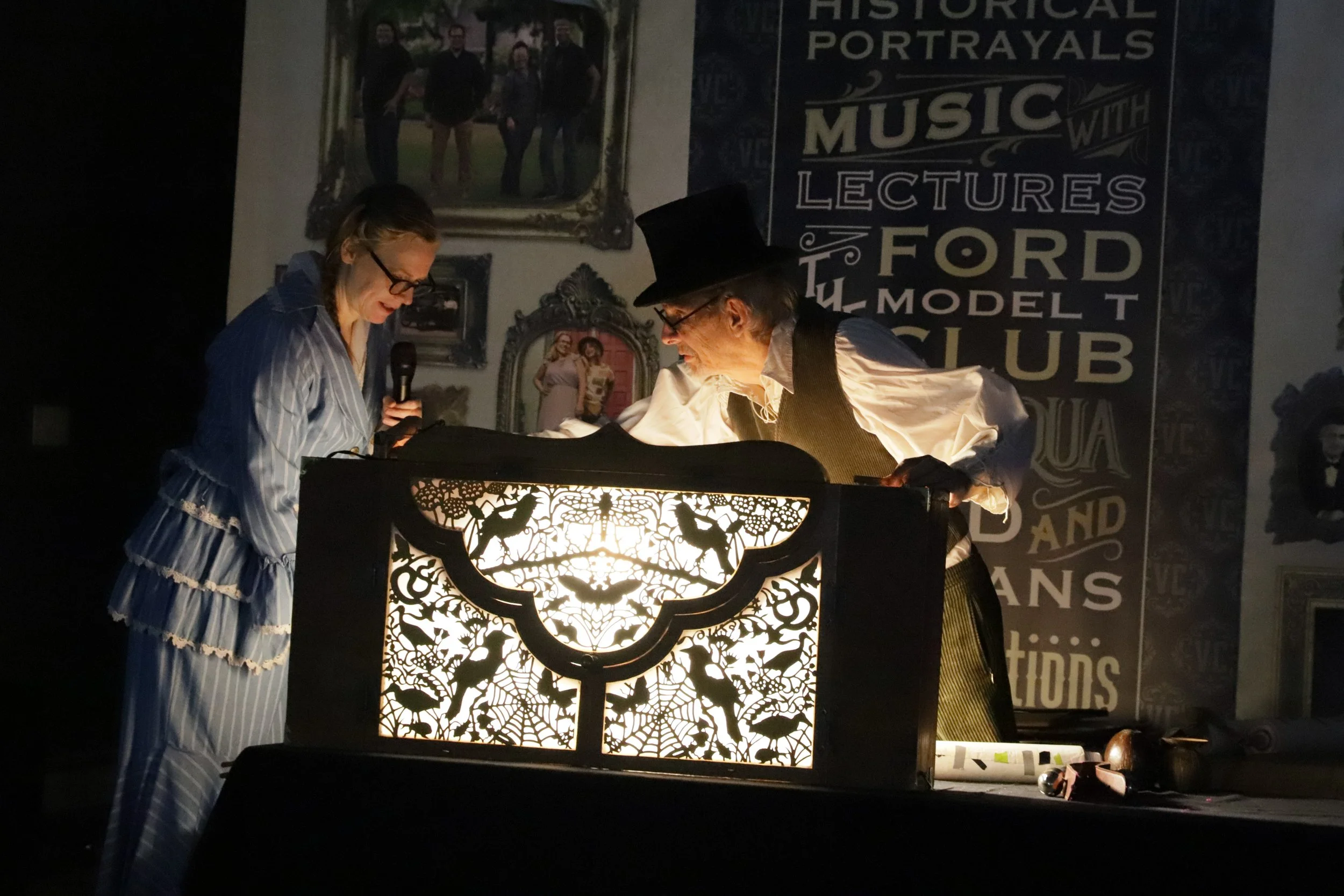A Good Reason To Be Cranky
Dan Van Allen and Katherine Fahey turn shadow projections into works of art and tall tales.
Katherine Fahey has perfected the art of shadow play, also known as shadow puppetry. Katherine has her own adaptation of the art form, which she calls Crankies. Her multiple disciplinary presentations tap into her artistry of paper cutting, ethereal shadow puppetry, music, and captivating storytelling.
This ancient form of storytelling and entertainment utilizes flat, cut-out figures or shadow puppets, which are held between a source of light and a translucent screen or scrim that faces her audience. The simple mechanics are a wonderful reflection of a bygone era, making her presentation a great addition to the 2022 Victorian Chautauqua. A collection of short stories will make up her program on Saturday, July 9, 2022, and has been generously funded by Jeff and Elizabeth Rees Gilbert and co-funded by the Schlattman Family. While Katherine stands behind her miniature theatre to narrate tales, the audience will watch the illuminated show unfold before them.
The cut-out shapes of the puppets sometimes include translucent color or other types of detailing to create a sense of dimension. Various effects can be achieved by moving both the puppets and the light source. Fahey manages to manipulate the objects in her performances so each story is brought to life while she sparks the imagination. Her original scripts tell relevant, meaningful, and sometimes humorous stories.
Out of the Shadows
Known as the Jane Appleseed or matron saint of Crankies, Katherine has toured, performed, and taught her craft nationwide. Her pieces are based on tunes and tales as far-reaching as the southern swamps of Louisiana and the northern reaches of Inuit Quebec.
Crankies are presented as tabletop performances with Katherine’s fellow puppeteer and foley artist, Dan Van Allen. The tabletop stage has a scroll that is advanced to change scenes in somewhat of a timeline, which enhances the story as it is told. Additional animated shadows interact with the scrolling artwork to create a theatrical interpretation in shadow form.
Shadowplay has a long history in Southeast Asia, especially in Indonesia, Malaysia, Thailand, and Cambodia. It has been an ancient art and a living folk tradition throughout Northern Africa, Europe, and the United States as well.
Performances are choreographed behind a thin screen with flat and sometimes jointed puppets that can have transparent or colored areas. The puppets are usually held close to the screen and lit from behind, while hands and arms can sometimes be manipulated with attached canes or allowed to swing freely. Shadows can change size or focus depending on how close or far they are to the screen.
Complex Yet Simple
The magic of presenting a Crankie happens behind an illuminated box. Bright light allows for cutouts to cast shadows that can move about and appear to be alive when viewed by the audience. This complex use of layers, light, and choreography, creates a flowing visual story using simple technology. A decorated scroll acts as a projection screen while providing an evolving environment. The objects and characters controlled by the puppeteers playfully interact against the moving panorama.
While shadow play theatre is an Asian invention, hand puppets have a long history in Europe as well. As European merchant ships sailed in the search of sea routes to India and China, they contributed to popularizing this opulent art form back home. Shadow theatre became popular in France, Italy, Britain, and Germany by the 17th century. In France, where its popularity grew quickly, shadow play was advertised as ombres chinoises [French for Chinese shadows], while elsewhere they were called magic lantern.
Shadow plays started spreading throughout Europe at the end of the 17th century and several Italian showmen were known to performed in Germany, France and England during this period. In 1675 German polymath and philosopher Gottfried Wilhelm Leibniz imagined a kind of world exhibition that would showcase all kinds of new inventions and spectacles. Included in his handwritten wishlist was shadow theatre.
As early as 1771, French showman François Dominique Séraphin first presented his shadow spectacle in a hôtel particulier in Versailles. He continued to perfect his craft and eventually performed at the Palace of Versailles, attracting royalty from the audience. Thirteen years later, Séraphin moved to Paris to perform his shows at his permanent theatre in the newly opened Palais-Royal. Séraphin took shadow plays to a new level by integrating the use of clockwork mechanisms to automate his shows. His nephew maintained his uncle’s show after Séraphin's death in 1800, and it was continued by subsequent heirs for another 70 years before the theatre eventually closed.
Asian Influence
In 1776, French missionaries introduced the shadow show after seeing it in China. They gave performances in Paris and Marseilles, causing quite a stir and cultivating new audiences. In time, the ombres chinoises with local modification and embellishment, became the ombres françaises and earned its place as a permanent form of entertainment in the country.
The art was a popular form of entertainment in Paris during the 19th century, especially in the famous Paris nightclub district of Montmartre. The cabaret Le Chat noir ("The Black Cat") produced 45 Théatre d'ombres shows over the course of eleven years beginning in 1885 under the direction of Rodolphe Salis. Behind a screen on the second floor of the establishment, the artist Henri Rivière worked with up to 20 assistants in a large, oxy-hydrogen back-lit performance area and used a double optical lantern to project backgrounds. Figures began as cardboard cut-outs but, in just a few years, were replaced with ones made of zinc, which were more durable. Many of them have survived time and are part of museum collections. Another popular show, L'Epopée, which premiered in 1888, engaged various accomplished artists to design 50 cut-outs. By this point, shadow theatre had made its indelible mark on artistic theatrical productions.
Intricate designs create an imaginary world that help to tell a story. The illuminated stage makes the silhouettes appear dimensional and alive.







